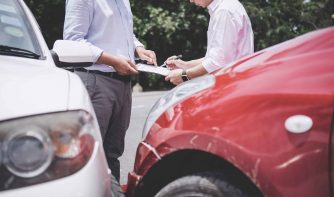It depends on the circumstances of your accident. Your car accident attorney will first want to sort out who was at fault (or mostly at fault). If the crash was primarily your responsibility (more than 50 percent), the uninsured driver can still sue you or seek compensation from your auto insurance policy for their damages.
What Happens to Uninsured Drivers in an Accident?
The responding police officer will cite the uninsured motorist for driving without insurance. Depending on their existing driving record, they will probably pay a fine of $500 -1,000 and face a license suspension. However, the uninsured driver still has a right to seek compensation in civil court if you caused the accident. If you’re unsure about fault in a car accident, regardless of anyone’s insurance status, please speak to a lawyer right away.
If the crash is primarily the uninsured driver’s fault, you would typically pursue compensation from their car insurance policy – but they don’t have one. Fortunately, there are other avenues for recovering damages in most cases.
You Can Sue the Uninsured Driver
Even if the other party doesn’t have insurance, they can still be held legally responsible for damages they caused. You can file a lawsuit, and we will try to work out a settlement with the other driver and their lawyer the way we usually would with an insurance company. If we can’t agree on a fair amount, we may proceed to trial, and if we can provide enough evidence that the other driver was at fault, you will have a good chance of winning.
But in reality, a lawsuit isn’t always a good idea. Even if the evidence in your favor is strong, there is no point in going through the expensive, stressful, and time-consuming process of a lawsuit if the other driver can’t afford to pay the judgment. Unfortunately, someone who can’t afford car insurance may not be able to afford to pay your damages, either. However, lack of money is not the only reason people sometimes drive without insurance, so your lawyer will look into the other party’s finances before advising you on whether a lawsuit is likely to be worthwhile.
You Can Seek Coverage from Your Own Uninsured/Underinsured Motorist Insurance
Hopefully, you have uninsured/underinsured motorist or UI/UM coverage on your auto insurance policy. (Unlike liability coverage, UI/UM is not required in the states of Wyoming and Colorado.) If you don’t have this coverage, we recommend adding it to your policy. It won’t help with an accident that’s already occurred, but it can protect you in any future situations where a motorist without sufficient insurance causes you damages.
In cases where the at-fault driver is uninsured and doesn’t have the means to pay a judgment for the client’s damages, we often recommend using UI/UM instead. We file a claim with the client’s insurance company, including evidence of the other driver’s fault and lack of insurance. Most of the time, the insurance claim process is faster than a court case would have been, and the insurance company can afford to pay the settlement.
What Happens if the At-Fault Driver Has Insurance, But Not Enough?
This is a common problem in more serious accidents where the client has sustained severe injuries. They may have high-dollar medical bills, weeks or months of lost income, permanent disability, and other damages like pain and suffering. In such cases, the damages could easily be six or even seven figures, possibly outpacing the at-fault driver’s insurance coverage.
Every insurance policy has a limit, and state laws mandate a minimum amount of coverage for an auto insurance policy. In Wyoming, the minimums are $25,000 in liability coverage for bodily injury per person ($50,000 per accident) and $20,000 for property damage. Colorado has the same limits for bodily injury liability and requires only $15,000 for property damage. These are minimums, and policyholders can purchase much more significant amounts, so you shouldn’t assume this is all the coverage available for your accident. Your attorney will check on the relevant policy limits for you.
But suppose you were in an accident and the driver who caused it had this minimum coverage. If your injuries were substantial and your health insurance didn’t cover everything, your medical bills alone could exceed $25,000. If you missed three months of work while recovering, your lost wages could be thousands more. What if you were permanently disabled by your injuries and unable to return to work? Your damages could be hundreds of thousands of dollars. How would you recoup that from a $25,000 policy?
The answer is that you can’t. You can, however, use a stacked UI/UM policy to recover any damages left over after the other driver’s policy pays the $25,000. So if you have a UI/UM policy for $25,000, you could recover $50,000.
Car accidents can cause life-altering injuries and leave you with significant financial burdens. If you’ve been hurt due to someone else’s negligence, you may have the right to compensation. Our car accident lawyers are here to help you get justice.
What is the Difference Between a Stacked and Unstacked UI/UM Policy?
In Colorado and Wyoming, both stacked and unstacked policies are allowed. A stacked policy allows you to collect up to the policy limit on both your UI/UM insurance and the other driver’s liability policy, as in the example above. An unstacked policy only ensures that you will have the amount of coverage you bought available. If you’ve already received $25,000 from the other driver’s liability insurance, you can’t collect anything from your unstacked policy. (If you’re unsure which kind of UI/UM coverage you have, check with your insurance agent.)
If you don’t have enough coverage between your own insurance and the other driver’s policy, you can also pursue a lawsuit against the at-fault driver, but again, this may not be worth the time if they lack any significant assets we can seize.
In Some Situations, You Can Sue a Third Party
This is not an option in every case, but sometimes another party may have contributed to the accident, making the crash or your injuries worse. For instance, the uninsured driver may have pulled out in front of you, causing the collision. But if your airbag failed to deploy, you might have suffered more severe injuries than with a correctly functioning airbag. In such a situation, you could have a claim against the airbag manufacturer.
Are You Out of Luck If an Insurance Company Denies Your Claim?
Not necessarily. Whether you’re dealing with another driver’s liability policy or your own UI/UM policy, you should contact a car accident attorney for a second opinion. In many cases, we can refute the insurance company’s claims and recover a settlement for our clients. If you haven’t yet filed your claim, we can also assist you in filling out the forms and avoiding pitfalls that give the insurance adjuster an excuse to deny your claim.
Get Help with Your Car Accident Claim from the Olson Personal Injury Lawyers
Insurance adjusters are experts on insurance law, and most policyholders don’t have the knowledge to fight an insurance company alone. Attorney Sean Olson established Olson Personal Injury Lawyers to help injured people get the compensation they deserve, and he personally meets with every client to learn their story. If you’ve been injured by an uninsured driver – or an insured one – please contact Olson Personal Injury Lawyers to learn your options for recovering damages in your case. Your initial consultation is free, and we won’t charge you anything until we win or settle your case.







